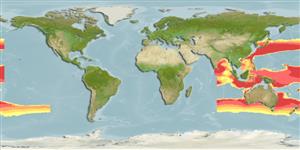Classification / Names
ชื่อสามัญ | ชื่อพ้อง | Catalog of Fishes(สกุล, ชนิด) | ITIS | CoL | WoRMS | Cloffa
sub class Elasmobranchii (ฉลามและกระเบน) (sharks and rays) >
Squaliformes (Sleeper and dogfish sharks) >
Dalatiidae (Sleeper sharks)
Etymology: Squaliolus: Diminutive of squalus (L.), a sea-fish, usually applied to sharks, referring to small size of S. laticaudus (See ETYFish); aliae: In honor of the Teng’s wife Huang A-li, for her “cordial help and constant encouragement” [originally spelled alii; since name honors a woman, aliae reflects the correct gender] (See ETYFish).
Eponymy: Huang A-li is the name of Teng’s wife. He named the shark, which was first caught inTaiwanese waters, after her “…for her continuous encouragement and assistance over the past 20-some years”. (Ref. 128868), visit book page.
Environment: milieu / climate zone / ระดับความลึก / distribution range
นิเวศวิทยา
เกี่ยวกับทะเล,น้ำเค็ม สัตว์ผิวน้ำในเขตน้ำลึก; ระดับความลึก 200 - 2000 m (Ref. 6871). Deep-water
Western Pacific: Japan to Australia (off northwestern Australia and New South Wales).
Length at first maturity / ขนาด / น้ำหนัก / Age
วัยเจริญพันธุ์: Lm ?, range 15 - ? cm
Max length : 22.0 cm TL เพศผู้/กระเทย; (Ref. 6871)
เงี่ยงครีบหลัง (รวม) : 1; เงี่ยงครีบก้น: 0. The smalleye pygmy shark, Squaliolus aliae, is a very small dogfish (about 22cm) characterized by its small eye, with diameter about 46-70% of interorbital width, and with upper margin angular and chevron-shaped; upper lip with a pair of prominent lateral papillae (rarely indistinct) (Ref. 31367, 6871).Colour: dark brown to black, fin margins pale (Ref. 6871). Squaliolus are the only sharks with a fin spine on its first dorsal fin (spine sometimes concealed by skin) but not on its second dorsal fin; second dorsal fin long-based and low, about twice the length of the first dorsal fin base; first dorsal-fin base closer to pectoral fins than to pelvic fins; and caudal fin nearly symmetrical, with subterminal notch present (Ref. 247, 6871).
Body shape (shape guide): elongated.
Possibly the smallest living shark (Ref. 6871). Found near continental and island land masses (Ref. 31367). Feeds mainly on cephalopods and small midwater bony fishes (Ref. 6871). Probably makes diurnal vertical migrations from within 200 m of the surface at night down to about 2,000 m during the day (Ref. 6871). Ovoviviparous (Ref. 6871).
Life cycle and mating behavior
วัยเจริญพันธุ์ | การสืบพันธุ์ | การวางไข่ | เซลสืบพันธ์ของเพศเมีย(ไข่) | ความดกของไข่ | ตัวอ่อน
Distinct pairing with embrace (Ref. 205). Ovoviviparous but litter size unknown (Ref. 6871). Males mature at 15 cm (Ref. 31367).
Last, P.R. and J.D. Stevens, 1994. Sharks and rays of Australia. CSIRO, Australia. 513 p. (Ref. 6871)
IUCN Red List Status (Ref. 130435: Version 2025-1)
Threat to humans
Harmless
Human uses
การประมง: ไม่มีผลประโยชน์
เครื่องมือ
Special reports
Download XML
แหล่งที่มาจากอินเตอร์เน็ต
Estimates based on models
Preferred temperature (อ้างอิง
123201): 4.6 - 10.1, mean 6.5 °C (based on 559 cells).
Phylogenetic diversity index (อ้างอิง
82804): PD
50 = 0.7510 [Uniqueness, from 0.5 = low to 2.0 = high].
Bayesian length-weight: a=0.00309 (0.00142 - 0.00675), b=3.14 (2.94 - 3.34), in cm total length, based on LWR estimates for this (Sub)family-body shape (Ref.
93245).
ระดับชั้นอาหาร (อ้างอิง
69278): 4.4 ±0.57 se; based on food items.
ความสามารถในการกลับคืนสู่ปกติ (อ้างอิง
120179): ต่ำ, เวลาต่ำสุดที่จะทำให้ประชากรเพิ่มขึ้นเป็น 2 เท่าใช้เวลา 4.5 - 14 ปี (Fec assumed to be <100).
Fishing Vulnerability (Ref.
59153): Low vulnerability (12 of 100).
🛈
